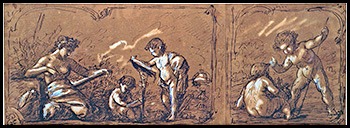


Although late nineteenth-century America did not have any substantial tradition of mural work on its shores, the Gilded Age provoked interest in the private domestic use of the decorative arts. Juglaris hoped to tap this fresh interest through his own talents in designing original murals, as well as friezes--broad horizontal bands of painted wall decoration near the ceiling. Juglaris’s May-June 1881 Boston exhibition with John Ward Dunsmore included a cartoon for an elaborate and allegorically-rich frieze decoration. A Boston art critic described it:

“The most important feature of the exhibition is Mr. Juglaris’s great allegorical cartoon of the ‘Triumph of Truth.’ Here may be seen in a marked manner, aside from color, the artist’s strength and weakness. Truth is represented in a chariot, preceded by Time and ‘La Rinomanza.’ At her right hand is History, at her left Fortune. In the space above them hover the Hours of Day. Beneath, at the right, are nude figures that represent Discord, Vice and Crime; at the left are martyrs awakened by the light of truth. The picture strikes the eye with great force as he enters the gallery. The onward movement of the steeds and chariot, on an extended cloud, with the attendant Hours, combined with nude forms beneath, which assume, in their thankful and exultant awakening, or their despairing and malignant hate, effective and varied attitudes, could have been produced only by a vivid imagination, with bold conception and ready and experienced hand. To our mind a marked weakness in the work is the figure of Truth… It stands in a manner too stiff and stagy, which robs it of both force and graceful beauty.”

While the Triumph of Truth never became an installed work, elements of the frieze later appeared in Juglaris’s Hours commission at the Franklin Public Library. Biding his time, Juglaris devoted himself to whatever simpler frieze projects came his way. For these friezes Juglaris usually incorporated images of children who were “apt to be rather Rubens-like in their plump rotundity.” Critics noted that Juglaris’s “children are full of life and action, and many of them… charming.”

Juglaris’s first frieze commissions were for the Prescott home in Newton, Massachusetts (1882), near the present-day campus of Boston College, and the Barnes residence in Syracuse, New York. Noting that Juglaris had apprenticed with the famous French painter Thomas Couture; completed decorative work for the Paris Opera House; was represented as an artist in the collections of Italy’s royal family; and had attracted much “attention in this country” with “a large, semi-nude work, entitled ‘The Invasion,’ which was shown at the exhibition made at the Museum of Fine Arts nearly two years ago,” Boston’s Folio arts journal highlighted his Prescott commission. As its August 1882 issue remarked: “We take great pleasure in presenting to the readers of the FOLIO the accompanying engraving of a section of frieze decorations designed and painted by Tommaso Juglaris, whose recent work has brought him great prominence here. The designs were made for the house of C. B. Prescott, of Newton, and were shown for a few days at the gallery of the Boston Art Club before being put into position. The section of the design we present represents half-a-dozen Flemish children in the quaint costume of the sixteenth century, dancing to the music furnished by the seventh in a species of Flemish bagpipe, and their action is very charming.”
Subsequently, in 1883, Juglaris beat out fourteen other contestants to win a much-publicized competition to decorate the Music Room of Massachusetts Governor Oliver Ames’s new Back Bay residence on Commonwealth Avenue. At that time the Ames home was the largest and most extravagant mansion in Boston. Juglaris’s preparatory sketches for the project were exhibited at an informal monthly exhibition hosted by the Boston Art Club. A local art critic remarked: “These panels comprise a series of scenes in which nude or lightly-draped childlike figures are playing on musical instruments, dancing, reading together, etc., the prevailing tone being very light and delicate in brilliant but subdued tints and colors. They are from the brush of Mr. Thomas Juglaris who has no superior in this country as a decorative designer where the human figure is concerned, and on this occasion has certainly exceeded in variety and gracefulness of competition, line and color of any of his former efforts in this direction.”
Several years afterwards, Juglaris also painted friezes for the residence of Dr. Homer M. Jernegan located almost directly across Commonwealth Avenue from the Ames mansion. A Boston newspaper acknowledged Juglaris’s latest commission, noting that it was being “painted with much force and vigor.” Another newspaper added: “Thomas Juglaris is busy at work upon a set of friezes for the new residence of Dr. H. M. Jernegan on Commonwealth ave [sic]. They represent chemistry, temperance, and surgery, literature, and another, which is of a professional nature. The work is of high character and possesses the artistic merit characteristic of Mr. Juglaris’s work.” Although Juglaris’s friezes at the Barnes and Ames Mansions survive to this day, other examples of his frieze work have since been stripped away, victims of the remodeling and re-purposing of buildings.